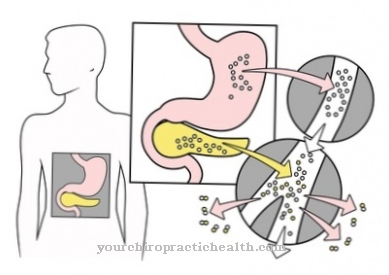The following article deals with the basic posture of the Lying down. After a preceding definition, it is shown which tasks, functions and what uses lying down fulfills for people. Illnesses and ailments that result from poor posture or are otherwise related to this body position are also discussed.
What is lying?

Lying down is a physical, human activity. It forms the opposite pole to the skills of standing and running. This activity is not used for locomotion, but is mainly taken to enable physiological regeneration.
The storage in this position always takes place in connection with a selected substrate. This can be chosen depending on the situation, but also culturally and individually. Different shapes of sofas, beds or other furniture can be chosen from the bare floor in order to offer the highest possible quality of comfort for resting.
Basically, the human body is in an approximately horizontal position parallel to a specific base. An independent decision for positioning in a position is just as possible as an externally induced positioning in the event of illness. Lying down usually also initiates the physical and mental rest state of sleep. A distinction must be made between the following lying positions: back, prone and side position. Mixed forms and different head positions are further distinguishing criteria.
Function & task
Sleeping is a physiological necessity, is one of the basic human needs and is optimally regenerated in a lying position. The average person spends a third of their entire life lying down. In this position, only a minimum of muscle activity is required. It is therefore the main task of this posture to give the human body and mind space for regeneration. During the day, the weight of every body is on a person's joints and muscles as they move. In the extended position, the musculoskeletal system is freed from this weight; the muscles are relieved with little energy expenditure and can relax.
Suitable sleeping pads in the form of mattresses that are adapted to the body, as well as pillows and a temperature-adapted blanket, play an essential role in ensuring a high level of functionality. The aim is to achieve a physiologically natural curvature of the spine in the double S. Important parameters for this are the degree of firmness of the mattress as well as the height of the pillow and a suitable lying position.
The higher the body weight, the harder the mattress should be. When lying on your side, the pelvis and shoulder must be able to sink in equally deep so that the spine does not sag. An orthopedic pillow supports this. No hollow back or overstretching of the neck muscles should take place in the supine or prone position. Support cushions under the knees for back sleepers and at hip level for those who sleep on their stomach reduce the risk. So the trunk muscles can be relieved to the maximum.
Frequent change of position is important to avoid discomfort. The body regulates this itself during sleep and ensures that posture is constantly optimized. The average sleeper moves 60 times per night with a normal sleep rhythm. One-sided loads are thus prevented. When the back is stretched out, the intervertebral discs absorb more fluid during sleep and thus regenerate the vertebral system. The choice of the sleeping place and the lying position with sufficient freedom of movement are decisive in order to guarantee the maximum functionality of the lying position for body and mind.
You can find your medication here
➔ Medicines for painIllnesses & ailments
Unsuitable lying surfaces and poor posture can cause avoidable complaints and diseases. A common source of errors are pillows that do not support the cervical spine, so that they create a kink in the cervical spine. This can cause circulatory disorders and long-term nerve damage. Neither excessive flexion due to pillows that are too high in the supine position nor overstretching of the cervical spine due to pillows that are too flat are recommended.
The prone position is the most unhealthy lying position, as it promotes a hollow back and high vertebral strain from neck rotation. The natural correction of the lying position and change of position during sleep should not be hindered or restricted. This can happen, for example, if the mattresses are too old and form recesses and thus prevent the spine from stretching. Mattresses should be replaced after 10 years.
High physical tension and tension in the neck, shoulder and lumbar vertebrae are common secondary symptoms. Stiff limbs, asleep, pain in the lower back or lying on your side in the hips, thighs or knees can also result. Lumbago and herniated discs result in many cases from a hunched back in the embryonic position.
The back should also be kept straight when resting. Posture in the wrong position can lead to difficulty falling asleep or waking up frequently. This in turn promotes obesity and depression, because the psyche and body cannot regenerate sufficiently. Physiotherapists correct these bad postures. Back and abdominal muscles training (straight and inclined) are suitable for preventing back problems.
Lying down is predestined for sleeping, but it can also be the result of external influences and illnesses. Severe fractures, paralysis, multiple sclerosis and comatose conditions, among others, do not allow affected people to sit, stand or walk due to a lack of muscle control. They are dependent on external care and help in order to keep the risk of further secondary diseases low. Long-term storage can result in poorly healing wounds (decubitus) due to lack of exercise and reduced blood flow with increased pressure. There is also a risk of muscle wasting, shortening of muscles, ligaments and tendons, and stiffening of joints (contractures).
























.jpg)



